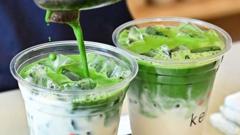Amid a whirlwind of matcha fever, the global demand for this vibrant green tea is straining supplies and reshaping consumption habits. Originating from Japan, matcha has recently infiltrated mainstream menus from coffee chains to dessert shops, spurred by social media influencers and a renewed interest in Japanese culture. The hashtag "Matcha Tok" has garnered millions of views, reflecting its rising prominence in culinary circles.
As matcha gains traction particularly amongst post-pandemic travelers to Japan, the tea's popularity has led to heightened demand that is outpacing supply. Lauren Purvis, founder of Mizuba Tea Co., revealed that cafés across the US are scrambling for matcha, with some requiring as much as a kilogram per day to meet customer expectations. However, this spike in demand coincides with climatic challenges, as Japan faces heatwaves that threaten tea crops and a demographic crisis with fewer young farmers entering the industry.
In regions like Kyoto, where matcha's prized tencha leaves are cultivated, tourists are often left empty-handed, compelled to limit purchases due to the scarcity of stock. Established establishments like Camellia Tea Ceremony limit customers to just one tin of matcha, highlighting retail frustrations. To cope with slow replenishment, companies are witnessing a rise in prices, with estimates showing increases as high as 30% this year.
The growing market has prompted advocates for mindful consumption, who express concern over widespread hoarding and the misuse of high-grade matcha in cooking, where its nuanced flavors can be lost. The Global Japanese Tea Association emphasizes the importance of recognizing distinctions between matcha grades, encouraging consumers to favor lower-tier matcha for culinary uses, while preserving high-grade options for traditional ceremonies.
The matcha sector is also bracing for the effects of recent U.S. tariffs on Japanese imports, which are predicted to only drive prices higher. However, some industry insiders remain optimistic that the demand might level off within the next few years as the fervor shifts.
As matcha enthusiasts navigate this evolving landscape, calls for consciousness and respect towards this cherished product may help maintain the cultural integrity of this ancient beverage.






















